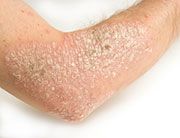Article
Possibility for Personalized Psoriasis Treatment on the Horizon
Author(s):
Psoriasis, plaguing patients with its seemingly incurable symptoms, may have met its match. Skylit Medical, a startup in San Diego, is developing a phototherapy device to use as treatment for psoriasis as well as eczema and vitiligo.

Psoriasis, plaguing patients with its seemingly incurable symptoms, may have met its match. Skylit Medical, a startup in San Diego, is developing a phototherapy device to use as treatment for psoriasis as well as eczema and vitiligo.
According to a consumer update from the US Food and Drug Administration (FDA), psoriasis treatments have evolved from a gradual approach to more targeted therapies catered to each patient’s specific requirement.
Melinda McCord, MD, dermatologist at the FDA said, “Tomorrow’s treatments will become even more personalized, because the drugs in development now are targeting different aspects of the immune system.”
Skylit founder and CEO Martyn Gross has long suffered from psoriasis and eczema. “We are a frustrated group, because this is an inflammatory condition for which there is no cure — so we spend $10 billion per year to solve this problem,” Gross commented.
The FDA recently approved a biologic product, Stelara, which contained an antibody that inherently prevents two proteins involved in spiking inflammation and mass skin cell production. “Targeting these proteins allows for the interruption of the inflammatory pathway,” said McCord. However, systemic and biologic drugs not only require the most funding, but also empty patients’ pockets rather quickly. Furthermore, one of the most common therapies, UVB therapy, poses another roadblock: it requires significant time necessary to successfully reap the benefits of regular phototherapy clinic visits.
A promising solution, the handheld device developed by Skylit administers an out-of-pocket subscription service allowing patients to lease and use the product at home, with ease. Once dermatologists provide their patients with the necessary prescriptions, the device is ready to go. Set in 30-second increments, the device will automatically shut off upon the day’s prescribed therapy is complete.
Skylit eventually hopes to build cameras within the device to allow dermatologists direct access to the therapy’s progress. As is, the device will include Wi-Fi and Bluetooth capabilities for the patients to manually send any information to their dermatologists. Nonetheless, according to experts at the National Eczema Associate, phototherapy is a highly beneficial therapeutic method reducing the itch while simultaneously increasing levels of Vitamin D.
Since symptoms vary from patient to patient, McCord concluded, “As we better understand the disease, researchers know more about what specific factors to target in order to develop effective treatments.”





